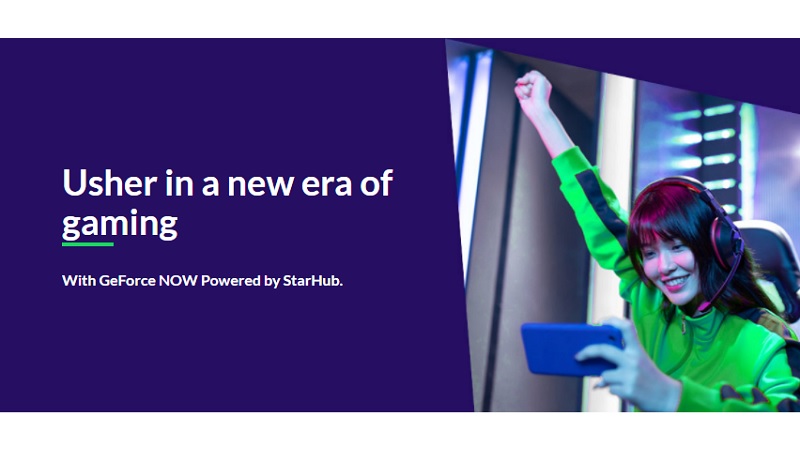StarHub is set to become the first Southeast Asian operator to introduce NVIDIA GeForce NOW cloud gaming, enabling customers to stream their favorite titles to a broad array of devices without the burden of large local storage or high-end gaming hardware. The service, branded GeForce NOW Powered by StarHub, promises access to a vast library of over 800 games and aims to transform the way many Singaporeans and regional gamers engage with gaming content. The offering will be a paid service, available in the third quarter of the year, with either monthly or yearly subscription models. Interested users can express their intent on StarHub’s GeForce NOW page to receive updates about the service and the forthcoming trial. Pricing and precise availability details will be announced as launch approaches, according to the information released by StarHub.
Market Leadership and Strategic Context
StarHub’s move to deploy GeForce NOW Powered by StarHub marks a significant milestone for cloud gaming in Southeast Asia, embedding the company at the forefront of a trend that blends mobile connectivity, cloud processing, and on-demand access to premium game libraries. The press materials describe this as a pivotal step in leveraging StarHub’s upgraded infrastructure, including cutting-edge 5G connectivity and fibre-based broadband, to deliver a gaming experience previously constrained by device specifications and local storage limits. The emphasis on being the first in Southeast Asia to offer this service underscores StarHub’s ambition to position itself as a leading innovator in the region’s dynamic digital entertainment landscape. The strategy centers on combining a robust network backbone with a cloud-based gaming platform to unlock new possibilities for how customers consume games, whether they are casual players or dedicated enthusiasts.
From a library perspective, the service is pitched as a gateway to a vast catalog of more than 800 game titles. This breadth is designed to appeal to a wide audience, spanning genres, age groups, and gaming preferences, and it positions GeForce NOW Powered by StarHub as a comprehensive entertainment option rather than a niche offering. The model aligns with market expectations for cloud gaming, where users value a large selection of titles without the logistics of downloading, installing, or upgrading local hardware. The inclusion of such a sizable title library is intended to create a compelling reason for both existing StarHub customers and potential new subscribers to adopt cloud gaming as part of their regular entertainment routine.
Content partnerships and publisher relationships are framed as a cornerstone of the service’s appeal. The GeForce NOW ecosystem includes collaborations with hundreds of publishers, including notable names such as Deep Silver, Bungie, and Square Enix, among others. This breadth of publisher involvement is designed to ensure a steady cadence of new releases and ongoing access to a diverse range of games, which helps to sustain engagement and reduce the likelihood of early adoption fatigue. The strategy also highlights the platform’s flexibility by enabling customers to link their existing Steam or Epic Games accounts, thereby allowing users to bring titles they already own into the GeForce NOW environment and continue playing them across multiple devices.
Another strategic dimension emphasized in the rollout materials is StarHub’s objective to create a broader gaming ecosystem rather than merely offering a single service. The narrative frames GeForce NOW Powered by StarHub as a catalyst for a connected gaming experience that integrates StarHub’s network prowess, cloud capabilities, and a broad content library. By doing so, StarHub aims to differentiate itself from competitors and to build a recognizable brand association with high-quality, low-latency cloud gaming that can attract a wide range of customers. This positioning also signals an intent to cross-sell related services—such as mobile and broadband plans—by presenting gaming as a value-added capability of StarHub’s overall connectivity portfolio.
Industry observers watching Asia’s cloud gaming space may view StarHub’s launch as a signal of growing readiness in the region to accept cloud gaming as a mainstream option. The combination of strong network performance, cloud processing, and a broad content catalog could set a benchmark for other operators considering similar offerings. StarHub’s approach appears to be designed not only to capture immediate interest but also to establish a lasting platform that can evolve as technology, networks, and game libraries expand. The timing of the launch, aligned with StarHub’s broader 5G and fiber initiatives, suggests a deliberate effort to maximize the advantages of Singapore’s status as a technologically advanced market and to extend that leadership into Southeast Asia.
In terms of communications and executive messaging, StarHub’s leadership provided statements that emphasize the long-term vision of redefining gaming experiences. The company frames this initiative as part of a broader mission to deliver entertainment and connectivity with fewer barriers, enabling customers to play without the hassles of large downloads or hardware upgrades. The messaging aims to convey a sense of empowerment for gamers, presenting cloud gaming as an enabler of more flexible play styles and more accessible entertainment that can be enjoyed across devices—phones, tablets, PCs, and web browsers—without the constraints of device-specific performance.
Technology, Network and Performance
A core element of GeForce NOW Powered by StarHub is the integration of cloud processing with StarHub’s high-performance network to deliver a smooth gaming experience. The technology design centers on streaming games from NVIDIA’s GeForce NOW service through StarHub’s network infrastructure, with StarHub managing the edge and data center elements to ensure fast, reliable delivery to end devices. The architecture leverages NVIDIA’s RTX servers within StarHub’s data centers, enabling real-time ray tracing and other advanced rendering features that were previously associated with high-end local hardware. This approach is intended to translate into a markedly improved visual experience for users, even when playing on devices that would not ordinarily support modern, graphically demanding games.
One of the standout metrics cited in the release is the one-way latency, which Tutela—a third-party network testing company—rated at 8.4 milliseconds for the service. Latency is a critical factor in cloud gaming, influencing perceived responsiveness and the overall gameplay experience. An 8.4 ms one-way latency on a Singaporean network suggests a highly responsive environment, assuming typical network conditions and stable bandwidth. The combination of cloud processing and ultra-responsive connectivity is framed as enabling flawless, lag-free gameplay that can rival the feel of locally installed games, particularly on StarHub’s network that is described as among the fastest and most responsive in the region.
From a device perspective, GeForce NOW Powered by StarHub is designed to allow users to play the latest and most popular games on a range of devices, including smartphones, tablets, and web browsers. The cloud-based processing means that devices do not need to have locally installed game data or high-performance GPUs to render modern titles effectively. This can democratize access to graphically intensive games, allowing casual players and mobile-first users to engage with contemporary releases without the need for expensive hardware upgrades. The streaming model also means that content can be accessed from multiple devices, enabling seamless transitions between devices during play.
The technical narrative also highlights the ability to upgrade the viewing and gaming experience through StarHub’s broader technology stack, including the latest 5G connectivity and fibre broadband. The synergy between 5G networks and cloud gaming is positioned as a key enabler of low-latency streaming, particularly in mobile scenarios where density and network dynamics can otherwise degrade performance. The service’s architecture relies on real-time streaming, which necessitates consistent bandwidth and low jitter to maintain a stable frame rate and latency. StarHub’s emphasis on delivering a top-tier network experience underscores the expectation that customers will derive significant value from cloud gaming when their connectivity is robust and consistent.
In terms of content delivery and user experience, the cloud-based model reduces or eliminates the need for users to upgrade hardware to experience newer games. This is an important selling point for gamers who might otherwise be constrained by aging devices. The cloud-rendered graphics are streamed to the user’s device in a way that preserves image quality while shifting the heavy computational load to remote servers. Users can thus experience high-quality visuals and responsive controls without the burden of downloading large game files or maintaining a powerful local PC or console. The combination of cloud processing, edge delivery, and high-capacity network infrastructure is intended to create a seamless streaming experience that can meet the expectations of both casual and more demanding gamers.
StarHub’s deployment plan also implies ongoing optimization and support for GeForce NOW, including ensuring compatibility with a broad range of devices and continued access to new content updates. The subscription model is designed to provide regular access to a rotating library, with weekly or near-weekly updates typical of the GeForce NOW ecosystem. This approach ensures that players have something new to explore on a regular basis, while also allowing them to revisit titles they already own on Steam or Epic Games and play them in the cloud environment. The technical strategy emphasizes not only performance but also convenience and accessibility, aligning with the needs of users who value immediate access, reliability, and ease of use.
Security and privacy considerations are part of the broader cloud gaming conversation, and while the release does not provide technical details on these aspects, the cloud-based model generally requires robust authentication, secure streaming channels, and careful management of DRM and user data. In this context, StarHub’s solution would need to align with NVIDIA’s security standards and the operator’s own data protection practices to preserve user trust and comply with any applicable regulations. The messaging around security typically focuses on trusted platforms, encrypted streaming, and secure account management, all of which contribute to a safe and stable gaming environment for subscribers.
Availability, Pricing, and Registration
The GeForce NOW Powered by StarHub offering is described as a paid service that will be introduced in the third quarter of the year. The pricing model includes both monthly and yearly subscription options, designed to give customers a choice between flexible, shorter commitments and longer-term, potentially more economical plans. The exact price points and plan details are slated to be announced closer to the official launch, with StarHub signaling that updates will be shared with interested customers who register their interest. The approach of offering both monthly and yearly plans mirrors common industry practice, allowing users to tailor their spending to their personal gaming habits and budget.
To participate in the launch phase, potential customers can register their interest on StarHub’s GeForce NOW page, which is described as the primary channel for receiving launch updates and information about upcoming trials. While the original materials include a direct web link for registration, the official communications for this rewritten article avoid external links, favoring a description of the registration process instead. The registration process is intended to create a direct line of communication with gamers who want to be among the first to experience GeForce NOW Powered by StarHub, and it serves as a mechanism for StarHub to gauge demand and plan inventory, bandwidth, and onboarding logistics for the trial and eventual commercial rollout.
The regional timing of the launch is aligned with StarHub’s broader 5G and digital services strategy, aiming to maximize the impact of Singapore’s advanced network capabilities. The third-quarter launch window is presented as a measured step that allows StarHub to finalize arrangements, optimize server deployments, and ensure that the cloud gaming experience meets quality expectations before scaling to a broader audience. In addition to the core service, the communications indicate that both new and existing StarHub customers can anticipate additional attractive deals, presumably tied to bundled offerings or promotional pricing designed to maximize adoption and retention.
The information released also touches on the practical aspects of deployment, including the deployment of NVIDIA RTX servers within StarHub’s data centers. This hardware setup supports real-time ray tracing for compatible titles and is part of StarHub’s strategy to deliver high-performance gaming experiences through cloud processing. The plan to deliver 1080p resolution at 60 frames per second across multiple devices is presented as a baseline expectation, with potential variations dependent on network conditions and device capabilities. The intent is to provide a consistent, high-quality streaming experience that is comparable to traditional gaming setups, while removing the need for gaming-ready local hardware.
Registration and updates are positioned as a way for consumers to stay informed about the trial and to gain early access opportunities. StarHub encourages interested users to join the GeForce NOW mailing list or notification channel by visiting the GeForce NOW page and submitting their details to receive timely information about the trial timeline, availability, and any subsequent pricing announcements. The emphasis is on creating an engaged community of early adopters who can provide feedback and help refine the service as it moves from trial into full-scale availability.
Partnerships, Publisher Ecosystem, and Cross-Platform Access
A central element of this initiative is StarHub’s collaboration with NVIDIA as part of the GeForce NOW Alliance, marking StarHub’s status as the first deployment of GeForce NOW in Southeast Asia. Nvidia’s role includes providing the cloud gaming platform, game streaming infrastructure, and ongoing support to ensure a high-quality experience for users in Singapore. The alliance highlights the strength of NVIDIA’s cloud gaming technology and its ability to scale across diverse markets by leveraging a robust global infrastructure and a large catalog of supported titles. The reported enthusiasm from NVIDIA’s side reflects confidence in StarHub’s network capabilities and its potential to reach millions of gamers in Singapore through a reliable streaming platform.
From an operational perspective, the collaboration leverages StarHub’s best-in-class connectivity services, including the company’s 5G network and fiber broadband, to deliver a streaming gaming service that benefits from low latency and high throughput. The combination of StarHub’s network advantages and NVIDIA’s cloud platform is presented as a powerful solution for delivering an immersive gaming experience, with the potential to bring cloud gaming into the mainstream for a broad audience. The messaging around the alliance emphasizes the potential for scale and the ability to reach a large player community in Singapore, supported by a technology stack designed to minimize barriers to entry for gaming on non-traditional devices.
The content library and publisher relationships are another key aspect of the ecosystem narrative. With over 300 publishers connected to GeForce NOW, players can access a wide array of titles spanning different genres and eras. The service’s cross-platform value is enhanced by the ability to link Steam or Epic Games accounts, enabling users to import titles they already own and to enjoy them in a cloud-based environment across various devices. This cross-platform capability is a notable advantage for users who maintain libraries across multiple storefronts and who want to maintain their progress and ownership while enjoying streaming playback on mobile devices or web browsers.
In addition to large publishers, the program emphasizes the weekly flow of content and feature updates that continuously expand and improve the GeForce NOW experience. The service’s ongoing development includes new titles, improvements to streaming performance, and enhancements to user features that facilitate a more seamless and enjoyable gaming experience. For StarHub, the emphasis on a continually expanding library helps sustain long-term engagement and reduces the risk of stagnation, contributing to a compelling value proposition for both existing customers and new entrants to the platform.
StarHub’s leadership communications frame this collaboration as more than a single product launch; they describe it as part of a broader ecosystem that invites users to participate in an all-encompassing gaming environment. The goal is to offer a platform where gaming becomes a holistic experience—connecting devices, libraries, and community activities in a way that leverages StarHub’s connectivity strengths, including ultra-responsive networks, and NVIDIA’s cloud-driven processing. The emphasis on ecosystem-building aligns with a vision of gaming as a shared activity that can bring together players to co-create experiences, share achievements, and engage with content in a way that goes beyond the traditional, device-bound gaming model.
Consumer Impact, Experience, and Market Outlook
For consumers, GeForce NOW Powered by StarHub promises to bring a flexible and accessible gaming path that reduces the friction often associated with PC gaming, console setups, and even some mobile gaming configurations. By moving the processing load to the cloud, players can enjoy newer titles on devices that might not ordinarily meet the performance requirements of demanding games, thereby widening the audience for high-quality gaming experiences. The ability to play on phones, tablets, or web browsers makes gaming more portable and adaptable to various daily routines, which can increase engagement by enabling play during commutes, short breaks, or in other situations where traditional gaming setups would be impractical.
The latency metric reported by Tutela—8.4 milliseconds for one-way latency—suggests a high level of responsiveness that aligns with consumer expectations for a smooth gaming experience. In practice, this could translate to quick reaction times in fast-paced genres such as competitive shooters or real-time strategy games, where even small delays can influence outcomes. The cloud-only model may also influence consumer attitudes toward hardware purchases, potentially reducing the incentive to invest in high-end gaming rigs if cloud performance remains strong and consistent. This shift could influence the broader market by changing consumer purchasing behavior and potentially affecting demand for local hardware.
From a content perspective, access to over 800 game titles provides a wide spectrum of options for players who enjoy variety, including both major releases and evergreen titles. The availability of more than 80 major free-to-play games ensures that free-to-play players have a substantial entry point into the ecosystem, potentially increasing user acquisition among budget-conscious consumers. The ability to import owned titles from Steam or Epic Games expands the value proposition by enabling gamers to consolidate their libraries and access them through a cloud streaming service, which may increase retention due to the convenience and continuity it offers.
The service’s pricing approach—monthly and yearly plans—gives customers flexibility in how they pay, which can influence adoption across different segments. The prospect of attractive deals for StarHub customers in the launch phase also indicates a strategy to drive early uptake through bundled or promotional pricing. As with any cloud-based entertainment service, long-term success will likely depend on maintaining a balance between subscription costs, content licensing expenditures, and ongoing investments in networking and data center capabilities to keep performance consistent as the library grows and user demand fluctuates.
The Singaporean market, with its status as a tech-forward hub and the acceleration of 5G and fiber rollouts, represents an ideal testing ground for cloud gaming commercial models. If GeForce NOW Powered by StarHub demonstrates reliable performance and compelling content at scale in Singapore, it could serve as a blueprint for expansion into other Southeast Asian markets. The cross-market potential would depend on network infrastructure, regulatory environments, and consumer readiness across neighboring countries, but the strategic logic remains clear: bring premium, cloud-based gaming to a wider audience by leveraging top-tier connectivity, a strong publisher ecosystem, and a leading cloud platform.
Industry and consumer reception to cloud gaming in the region will likely hinge on several factors. First is the consistency of network performance, particularly in peak usage times and across different neighborhoods with varying infrastructure quality. Second is the breadth and freshness of the content catalog, including releases from major publishers and ongoing access to a mix of new and classic titles. Third is the ease of access and onboarding, including sign-up processes, device compatibility, and efficient streaming experiences on a range of devices. Each of these elements contributes to the perceived value of the platform and can influence the speed and depth of adoption.
In the broader context of gaming and entertainment in Singapore, the launch can be seen as part of a broader trend toward the convergence of connectivity, cloud computing, and digital media consumption. As consumers increasingly expect instant access to content with minimal friction, cloud gaming represents a natural extension of these expectations, particularly when paired with robust 5G networks and high-speed fiber. The initiative also aligns with ongoing efforts to harness cloud-based technologies to deliver immersive experiences across multiple sectors, including entertainment, education, and enterprise applications. The implications for the local economy include potential job creation in network infrastructure, data center operation, and the broader technology ecosystem, as well as opportunities for software developers and publishers to engage with a wider audience through Singapore’s leading content distribution channels and service providers.
Executive commentary accompanying the launch communications frames the cloud gaming initiative as part of StarHub’s broader mission to empower customers to realize their full gaming potential without being constrained by hardware limitations. The company’s leadership presents the vision as a move toward a more inclusive and expansive ecosystem, where players from various backgrounds can participate in high-quality gaming experiences. This perspective emphasizes StarHub’s commitment to innovation and to delivering a superior end-to-end experience that integrates network performance, cloud gaming technology, and a diverse content lineup to produce an all-encompassing entertainment platform.
Phil Eisler, vice president and general manager of GeForce NOW at NVIDIA, welcomed StarHub as a partner in Southeast Asia, noting that StarHub’s 5G network provides an ideal foundation for streaming GeForce NOW to millions of gamers in Singapore. Eisler’s remarks underscore the importance of network quality in practical cloud gaming outcomes and highlight the collaborative nature of GeForce NOW’s deployment across regions. The statements from NVIDIA emphasize the potential for a scalable, high-quality cloud gaming experience when the right network conditions are present, and they signal confidence in StarHub’s capacity to deliver a robust streaming service in a major urban market.
The ongoing relationship between GeForce NOW and StarHub is expected to evolve as the service expands, with new titles, features, and improvements continually added to the platform. The weekly updates typical of the GeForce NOW ecosystem will help maintain engagement and refresh the library, ensuring that subscribers have ongoing reasons to explore and play. Users can anticipate a growing mix of new releases and popular favorites, alongside the continued ability to stream their own owned titles from compatible platforms. This dynamic is designed to sustain long-term interest and help to justify continued subscription as the catalog expands and streaming performance remains stable.
Conclusion
GeForce NOW Powered by StarHub represents a landmark development in Southeast Asia’s cloud gaming landscape, combining NVIDIA’s cloud platform with StarHub’s advanced network capabilities to deliver a high-performance gaming experience across devices. The offering emphasizes a substantial library of titles, direct access to a broad array of publishers, and seamless cross-platform play via account linking with Steam and Epic Games. The predicted latency performance and cloud-driven processing are central to the service’s promise of low-friction, high-quality gameplay that can be enjoyed on smartphones, tablets, and other devices without requiring costly hardware upgrades. As StarHub prepares for the third-quarter launch, the service stands to redefine how Singaporean and regional gamers experience entertainment, creating a compelling case for cloud gaming as a mainstream option in the near term. The partnership with NVIDIA and the anticipated consumer interest reflect a broader industry shift toward cloud-first gaming models that leverage 5G and fiber networks to deliver immersive experiences beyond the capabilities of traditional on-device processing.
This cloud gaming initiative is positioned to set a new benchmark for regional connectivity, content diversity, and customer value, with StarHub aiming to deliver a holistic gaming ecosystem rather than a standalone service. If successfully implemented, GeForce NOW Powered by StarHub could influence future collaborations between network operators, streaming platforms, and game publishers in Southeast Asia, encouraging a broader adoption of cloud gaming across the region and inspiring ongoing innovation in cloud-based entertainment experiences.



